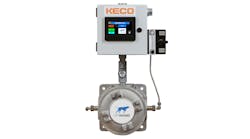by Gary D. Nichols, P. E.
As we bring this series of articles on lifetime costs and reliability of process analyzer systems to a close, we should spend time discussing additional sources of information. For better or worse, these sources are few. This is partially because the process analyzer community is relatively small, and partially because the area of process analyzer systems is specialized in comparison to, say, chemical engineering kinetics and reactor design, heat exchangers and process safety.
Some of the references cited are out of print, but it may be worth the effort to seek them out from used book sellers when possible.
Undoubtedly, there are other excellent texts, monographs, recommended practices and standards that specifically address on-line process analyzer systems; the author did not intentionally neglect nor minimize the value of any information sources or authors. The reader is further encouraged to find, use and share other sources with other analyzer system technicians and engineers. Not only are texts and monographs important, but the reader is highly encouraged to explore CII/PIP, ISA, IEC, API, ASTM, NFPA, other organizations that produce standards and recommended practices, and site and corporate standards and recommended practices.
API Recommended Practice 555 Process Analyzers, 2nd ed., 2001 (ANSI/API RP 555-2001) – This outstanding recommended practice, available by direct purchase or online subscription, is a combination of an analytical methods text and how-to practice. It is generous with text descriptions of chemical and physical analytical methods and calculations and illustrations of how to achieve workable process analyzer systems designs.
ASTM D3764-06 – Validation of the Performance of Process Stream Analyzer System. An excellent procedural and statistical description of how to validate analyzer systems. Glossary of terms is also included. Even when this ASTM procedure is not required, it is easily adaptable to demonstrate whether an analyzer system is performing as intended. Also lists related ASTM standards.
Carr-Brion, K. G. and J. R. P. Clarke. Sampling Systems for Process Analyzers, 2nd ed., Butterworth-Heineman, Oxford, U.K, 1996, 387+ pp., ISBN 0-7506-1247-9. This overview of gaseous, liquid, solid and heterogeneous sampling for online process analyzer systems is a valuable addition to any process analyzer system library. The authors make liberal use of diagrams and checklists to aid the user with analyzer applications. Separate chapters on safety, maintenance and project management are included. The chapters on solids and heterogeneous sampling are tedious at times, but reflect the U.K. origin of the book and the local needs. A detailed glossary of terms and symbols is also given.
CII/PIP – These are the Construction Industry Institute (CII) Process Industry Practices (PIP) for control systems (PIPs also exist for other engineering disciplines). They are available only by subscription or at individual cost from CII, affiliated with the University of Texas. Subject matter includes design and application of combustible and toxic gas detection systems, process analyzer systems, process analyzer field installation, process analyzer shelters, process analyzer bid proposals, process analyzer documentation requirements and testing process analyzer systems. Data sheets and text standards are provided, including instructions for completing the data sheets. The data sheets are downloadable to online subscribers, but the data sheets are limited as to their editability to adapt to specific corporate or application needs. Some subscribers supplement the PIPs documents with in-house addenda, instructions and standards
Clevett, Kenneth J. Process Analyzer Technology, John Wiley and Sons, New York, USA, 1986, 952 pp., ISBN 0-471-88316-6. Clevett’s book has long been the standard for process analyzer information. There are chapters on most process analytical methods, plus chapters on combustion efficiency, data systems, sample conditioning system design, process analyzer system installations, calibration and correlation, maintenance and analyzers in control systems. Unfortunately, the book is out of print and includes much information on analyzers that are obsolete. Despite the disadvantages, Clevett’s introductory explanations of the analytical methods are valuable to any process analyzer system technologist.
Houser, E. A. Principles of Sample Handling and Sample Systems Design for Process Analysis, Instrument Society of America, Research Triangle Park, N.C., USA, 1972, 108 pp. ISBN 87664-189-3. The owner of this now out-of-print book is the holder of a valuable historical reference in the field of process analyzer sample conditioning systems. Some of the information is dated and brought up to date in later sources (e.g. API RP555).
Huskins, D. J. Quality Measuring Instruments in On-Line Process Analysis, Ellis Horwood, Ltd., Chichester, West Sussex, UK, 1982, 455 pp., ISBN 0-85312-320-9. This book concentrates on refinery-type physical property analyzers by brand/model-specific applications. The basic operating principles of each type of analyzer are explained in detail. Except for oxygen analyzers, the book lacks depth in chromatographic and photometric analytical methods. Nonetheless, it is a valuable contribution to refinery analyzer libraries.
ISA RP76.0.01-1998 – Analyzer System Inspection and Acceptance. This recommended practice from ISA shows what buyers, specifying engineers, designers and end users should look for when inspecting packaged process analyzer systems, including those in shelters, for acceptance for delivery to intermediate suppliers or to the end user. Though most analyzer system vendors have developed their own checklists, this recommended practice provides guidance about what to expect once arriving at the vendor for an inspection.
McLennan, F., and B. R. Kowalski. Process Analytical Chemistry, Blackie Academic and Professional, (Chapman and Hall), London, UK, 1995, 378 pp., ISBN 0-7514-0038-6. This text is an interesting mixture of process analytical chemistry, on-line physical properties determinations, automated laboratory analyses, and chemometrics. It partially reflects the second author’s (BRK) affiliation with CPAC and the developments from that organization.
Manka, D. P., Ed. Automated Stream Analysis for Process Control, Academic Press, New York, USA, 1982, 323 pp., ISBN 0-12-469001-7. This is a multi-author, somewhat esoteric monograph about analyzers in nuclear power plants, pulp-and-paper plants, coke and steel plants, clinical laboratories and water-treatment plants. For specific applications, the chapter contents can be quite useful, but it omits many useful process analyzer systems applications addressed in sources such as Clevett and API RP555.
Mix, Paul E, The Design and Application of Process Analyzer Systems, John Wiley and Sons, New York, NY, USA, 1984, 312pp., ISBN 0-471-86518-4. This is an excellent book that combines analytical measurement theory, process analyzer instrument design, and field installation design. It includes separate chapters on basic sample systems, safety and maintenance and troubleshooting. The moisture analyzer chapter includes comments on corrosion monitoring, an often neglected area of process analysis. Though this book is likely out of print, it is an excellent addition to any process analyzer library.
Moore, Ralph L, Neutralization of Waste Water by pH Control, Instrument Society of America, Research Triangle Park, NC, USA, 1978, 159 pp., ISBN 87664-383-7. Also out-of-print, this is an early process analyzer reference on pH control in several types of neutralization reactors. It is a commendable resource for any process analyzer system organization with an interest in wastewater neutralization and treatment.
Nichols, Gary D. On-Line Process Analyzers, John Wiley and Sons, New York, USA, 1988, 300 pp., ISBN 0-471-86608-3. Nichols’s book is similar to Clevett’s, but has the advantages of being shorter and less expensive. Like Clevett’s book, Nichols’s book is out of print.
Sherman, Robert E, and R. E. Sherman. Process Analyzer Sample-Conditioning System Technology, John Wiley and Sons, New York, USA, 2002, 648 pp., ISBN 0-471-29364-4. This text explains how to use readily available industrial mechanical and electrical components to construct workable process analyzer system sample conditioning systems. Many manufacturers’ product cutsheets are reproduced in the book to demonstrate how to use the component or to show its operating characteristics.
Sherman, R. E., and L. J. Rhodes, eds, Analytical Instrumentation: Practical Guides for Measurement and Control, Instrument Society of America, Research Triangle Park, N.C., USA, 1996, 728 pp., ISBN 1-55617-581-7. Many authors from the process analyzer community contributed many hours writing their respective chapters for this book. Most chapters begin with the technology or theory of the analytical method and then go into process applications. Auxiliary chapters on sample conditioning systems, statistical methods, analyzer system installations, validation, etc., are also included. A few obsolete analyzers are sited, but this is a minor nuisance rather than a problem. The book can still be purchased from ISA at a cost affordable for most engineering and maintenance budgets.. It is an excellent substitute for Clevett’s book where the latter is not available.
Willard, Hobart H., Lynne L. Metcalf, John A. Dean, Frank A. Settle, Jr. Instrumental Methods of Analysis, 7th ed., Wadsworth Publishing Company, Belmont, CA, USA, 1988, 895 pp., ISBN 0-534-08142-8. This is an upper level/graduate level text that explains many instrumental methods of analysis, including those not currently in process analytical use. Though its scope is very broad, it is a useful text to have handy when answering questions about old and new technology. It includes a chapter on process analytical chemistry, though the chapter can be confusing, since it includes information on automated laboratory analyzers. The book may be out of print, but it is sufficiently current to help answer day-to-day questions about numerous process analytical methods.

Leaders relevant to this article:


